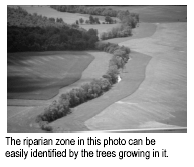Water: Middle School
Exercise VI. The Riparian Zone and Headwaters Streams
Riparian Zones

Riparian zones are the areas that border streams, rivers, lakes, and wetlands. They can be floodplains, streamside forests, or just plain streambanks. They are usually different from surrounding lands because they have unique soil and vegetation characteristics and are strongly influenced by water. Riparian zones are basically the interface between the water and the land, and they serve many functions, that make them valuable to people.
What Riparian Zones Do?
Water storage.
Riparian zones are able to hold water during a flood when the water rises out and over the banks of the stream. This function prevents further flooding downstream and also traps sediments and nutrients, making the riparian area a very fertile place.
Sediment retention.
Sediment from upland erosion can be trapped and retained in the riparian zone, preventing it from reaching local waterways, where it is detrimental to stream habitat, fish, and downstream drinking water supplies.
Nonpoint source pollution buffer.
Although riparian buffers can't absorb unlimited pollution runoff, they are effective at removing or storing a large amount of nutrients (nitrogen and phosphorus) and other contaminants. Riparian zones in agricultural areas have been shown to be extremely effective at reducing the amount of nutrients that reach local streams.
Streambank stabilization.
The root mass of trees, grasses, and shrubs helps to stabilize streambanks and prevent them from eroding.
Habitat.
Riparian areas are often more diverse than the adjacent upstream areas because this unique environment represents a gradient in vegetation, moisture, and soils that creates a number of habitats. Twigs, branches, and leaves falling from the riparian vegetation into the water also provide important in-stream habitat for aquatic organisms like insects and fish. This vegetation also provides a food or energy source that is important to the entire aquatic food web.

First-order Streams and Their Surroundings
First-order streams have a very strong relationship with their riparian zones. Because headwaters streams are narrower in general than higher-order streams, their banks influence the quality of the stream water and the amount of sunlight in the water. This in turn affects the biotic community in the water, which determines the health of the stream as it goes down its course.Restoring a First-Order Stream: The Soque River
Streams that are out of balance with their surroundings can be restored. The Soque River is a good example. Changes in land use resulted in an unhealthy stream that was washing away farmland at an alarming rate. An article on the Soque River restoration is provided at http: //www .epa .gov
/region04 /water /wetlands /projects /soque .html. [BROKEN]Pictures of the stages of restoration are at http: //www .epa .gov
/region04 /water /wetlands /projects /soqueepa .html. [BROKEN]
What happened in the riparian zone of the Soque River that caused it to become unhealthy?
Rapidly Expanding Cities Affect Streams
If you live in a headwaters watershed and your city is expanding rapidly-paving over fields and open spaces for new developments like roads, malls, residences, housing estates-how do you think the expansion will affect:
The volume of water flowing into the headwaters streams?
The quality of water flowing into the headwaters streams?
The fish and other organisms currently living in headwaters streams?
What does that mean?
Use this Web site to look up any words on river structure that you don't know: www .amrivers .org/glossary /default .htm . [BROKEN]
The temperature of the headwaters streams?
The level of sediment in the headwaters streams?
Middle Schools | Whatzzzup_Stream? | Exercises: I | II | III | IV | V | VI | Top
